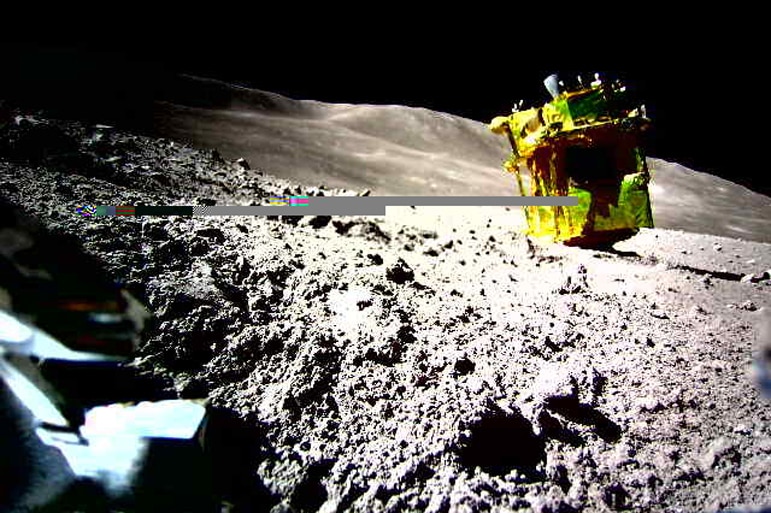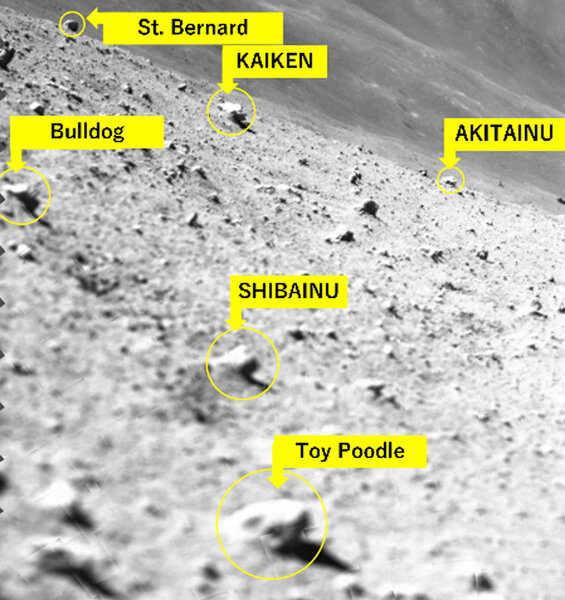Create a free profile to get unlimited access to exclusive videos, sweepstakes, and more!
Japan’s SLIM Lunar Lander Is Still Alive, Despite Landing Upside-Down
A bump on the head can't stop this Moon lander.
The events of SYFY’s The Ark (streaming now on Peacock) take a few liberties with their portrayal of space exploration, but the show gets one thing absolutely correct: things go wrong in space. All of the planning, testing, and dress rehearsals can’t compare to actually launching something into the abyss, and it’s almost guaranteed that mission controllers will run into problems they didn’t account for.
The 4.2 light-year trip to Proxima centauri provides plenty of opportunities for our fictional crew to encounter mishaps, but real-world scientists run into similar problems much closer to home. Recently the Japan Aerospace Exploration Agency (JAXA) launched a lunar lander to the surface of the Moon, and things didn’t go according to plan. For a minute there, it seemed that the agency’s SLIM lander, short for Smart Lander for Investigating Moon, was basically dead on arrival.
In actuality, it just needed a little nap while waiting for more favorable conditions. After more than a week in stasis, SLIM woke up and is busily snapping pictures from the surface of the Moon.
SLIM’s Trip to the Moon was a Mixture of Failure and Success
SLIM launched September 6, 2023, and took a leisurely, several-month trip to the Moon. It entered into lunar orbit toward the end of the year and made its final approach, landing on January 19, 2024. After a tense descent, SLIM touched down at Shioli Crater, near the Moon’s equator. The achievement made Japan only the fifth nation to successfully soft-land a craft on the lunar surface, but it wasn’t without speed bumps.
For More on the Moon:
The Moon Is Shrinking, Triggering Fault Lines and Moonquakes
Watch Russia's Crashed Luna-25 Punch a New Crater into the Moon's Surface
India's Chandrayaan-3 Successfully Lands on the Moon's South Pole
Something went wrong in the last moments of descent, and it wasn’t immediately clear what had happened. Mission controllers knew that the solar cells weren’t collecting energy from the Sun as planned, but it took days to figure out why. Over the course of the first few hours, the lander’s onboard battery fell to 12% charge and JAXA made the decision to power the lander down. It was a strategic move, leaving enough energy in the batteries to power the lander back up if and when the solar cells caught light.
In the meantime, JAXA confirmed that SLIM achieved its primary mission, landing approximately 55 meters from its intended target, making it the most precise landing ever achieved on the Moon. For contrast, Apollo 11 touched down roughly 6 kilometers (3.7 miles) away from its target.
JAXA's SLIM Lander Wakes Up After 9 Days in Stasis
An ongoing investigation into the cause of the Moon mishap suggests that one of the lander’s main engines lost thrust about 50 meters from the surface. It seems that the engine loss caused the lander to start flying sideways, tip over, and land on the Moon upside-down. Fortunately, two autonomous probes that detached from SLIM before things went sideways provided an outside perspective into what went wrong.
One of the probes, dubbed LEV-2, was able to snap a photo of the lander on the surface (above), confirming its upside-down orientation. Moreover, the solar cells were pointed away from the Sun, explaining why they didn’t start juicing the batteries after landing. That’s obviously not what JAXA was hoping for, but it also provided some hope that the lander might wake up at some future date. To understand why, let’s consider the sundial.
Sundials work by casting a shadow to mark the time. It’s an effective, if archaic, way of telling time because the sunlight’s angle of approach changes as a planet (or moon) rotates around its axis. On Earth, that happens once every 24 hours (give or take), but a day on the Moon is much longer. Because the Moon is tidally locked to the Earth, it only completes a circuit once every orbit, roughly every 29.5 Earth days. If SLIM had any chance of waking up, it would be when the Sun’s angle of attack shifted to hit the solar cells.
On January 28, JAXA announced on X (the website formerly known as Twitter) that the lander had woken up. After 9 days in limbo, the solar cells picked up sunlight and the topsy-turvy lander made contact. Despite being head over heels, SLIM fired up its multi-band camera and started taking pictures of the nearby lunar surface. It will keep snapping photos, investigating the mineral composition of the nearby landscape, until the Sun sets on that part of the Moon and SLIM goes to sleep, probably forever.
Already, the precision landing made SLIM an incredible success and a feather in JAXA’s cap, but its ability to land on its head and just keep going is a monument to engineering. Not bad, SLIM. Not bad.
Looking for another story of endurance in the face of space disaster? Catch the complete first season of The Ark, streaming now on Peacock.




































